Watching the breath, or watching the birds?
This is the third article in our series about the Rio de la Plata. Check out the first article and the second article in the series.
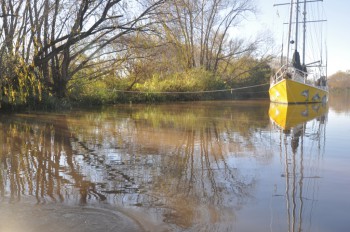
Life alongside the riverbank allows us an entirely different perspective on Mother Nature, for whereas at sea we are surrounded by her majesty but catch only glimpses of our fellow beings, here, amongst the trees, everything is much more cosy and the environment is thronged with life. When we visited this creek in the summer the trees were alive with insects, many of whom were as sociable as their compatriot, two-legged Argentinians. Wasps of various kinds came aboard and made themselves at home – or rather, made homes for their offspring – cicadas shrilled and crickets whistled; and mosquitoes… well, they, too, were abundant and very sociable, but they weren’t quite so welcome as their fellow citizens…
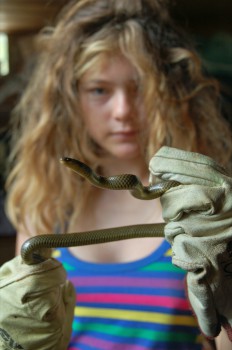
We also saw snakes, in the summer. They swam in the river, and one actually tried to climb aboard our boat. People tell us that there are lots of terrapins here, too, but we didn’t see any, and nor did we see the little alligators which, they tell us, sometimes wash down river with the floating islands after an exceptionally high tide.
Now, in the winter, the reptiles and the insects are sleeping, but the place is a bird-watcher’s paradise.
Six senses
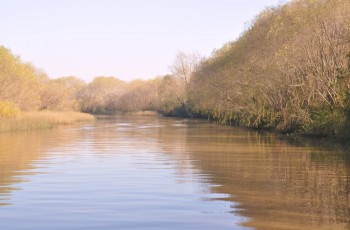
In the mornings I like to stand on the bow of the boat and meditate, and when I do this I sometimes begin by examining each of my senses in turn. My eyes, before I close them, take in the wintry, wet, greenish browns of the sleeping trees which are smudged against a grey sky and a muddy creek. I catch a faint glimmer of an understanding of what the Buddha meant when he said that life is just like the reflection in a pond, for those trees swimming in the water are neither real nor unreal. They are a magical mystery so familiar that we overlook it.
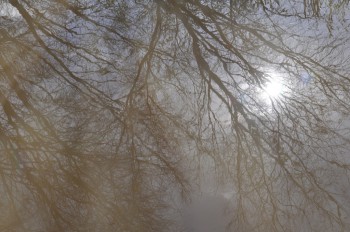 Next, having let my eyes fall shut, I see if my sense of smell can find anything on its radar. The delicious smell of wood smoke from our new cabin heater; a subtle earthiness from the wet mud-bank…
Next, having let my eyes fall shut, I see if my sense of smell can find anything on its radar. The delicious smell of wood smoke from our new cabin heater; a subtle earthiness from the wet mud-bank…
Next, taste – but at this time of the morning there’s just the slightly metallic flavour of saliva – and so I move on, to touch. I feel the deck soaking the heat from either foot; I feel the zephyr breeze teasing my hair and painting cold air onto my cheeks.
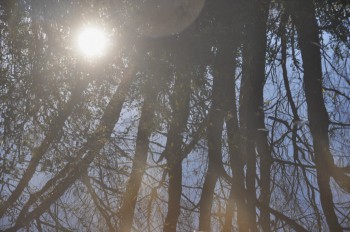 Thoughts are the last sense, and in a just a moment I will try to reign them in; I will try to let them be nothing more than clouds in the sky as I watch my breath. But before that, I examine my favourite sense; favourite, that is, while I am denied the sense of sight. Unable to receive any input from my eyes, the mind grasps at the information provided by my ears and I become aware of things that would normally pass unnoticed.
Thoughts are the last sense, and in a just a moment I will try to reign them in; I will try to let them be nothing more than clouds in the sky as I watch my breath. But before that, I examine my favourite sense; favourite, that is, while I am denied the sense of sight. Unable to receive any input from my eyes, the mind grasps at the information provided by my ears and I become aware of things that would normally pass unnoticed.
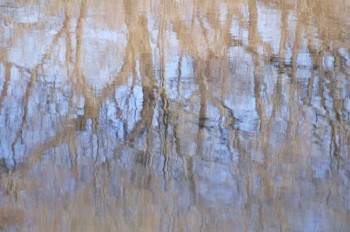 In the summer all other sound is drowned out by the zing-zing-zing of cicadas shrilling in the trees, but this year’s cicadas have yet to be born. In the summer, too, the trees block out the noise from the town, but while they are bereft of leaves the trees are not such an effective sound-barrier. Thus, in the winter, when I pay attention there are many things to hear:
In the summer all other sound is drowned out by the zing-zing-zing of cicadas shrilling in the trees, but this year’s cicadas have yet to be born. In the summer, too, the trees block out the noise from the town, but while they are bereft of leaves the trees are not such an effective sound-barrier. Thus, in the winter, when I pay attention there are many things to hear:
There is a distant roar of traffic on a far away highway.
And is that a plane…? No, it’s a speed boat, far off, on the river.
Water dripping from the tree roots as the tide falls. How can it be that I have never noticed that before? It’s so loud; so sharp; as constant as a metronome!
But the noise which dominates, when I close my eyes, is the sound of the birds singing.
Birdwatching on the Rio Luján
The first thing which struck me, on listening to the birds, was that I hadn’t a clue what most of them were. Whereas in a European woodland I can identify the song of almost every bird that I am likely to hear, there was hardly one voice amongst this choir which was familiar. Seabirds are mute, to all intents. They don’t have territories to defend, and their prospective partners are not hidden away; they will see one another long before they could hope to catch a melodious sexy song. Thus, it is a long time since I have had the chance to hear trills and whistles.
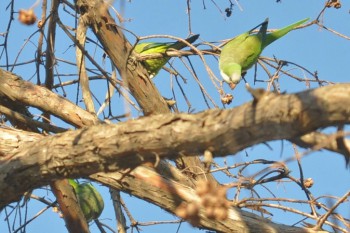
Closing my eyes and attending to my ears I hear pigeons, parakeets, and spur-winged plovers. The cooing of the pigeons is recognisable, it is true – but there are several species here, and I cannot name any except the wood pigeon. As for the parakeets – they go shrieking over the river sounding impossibly exotic; and when I open my eyes to identify them their bright green plumage, too, looks ridiculously tropical in these drab, winter surroundings. Their local name is cotorra.
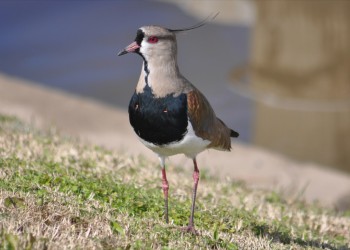
The plovers are called tero in Spanish. These birds are superficially similar to the European lapwing, but they are bigger and their temperament is rather different; and they have a nasty surprise – a trick weapon – which they wave in the face of unwary dogs and other potential trouble makers. They are familiar to me from our journey down the coast of Brazil, but I still haven’t got used to their shrill, noisy call. It seems so aggressive that it brings to mind a rabble of seagulls.
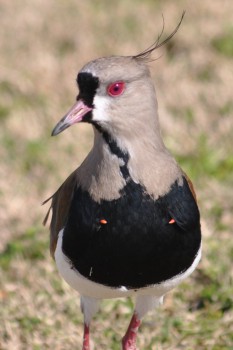
In reality, however, the local gulls are a mild mannered bunch – they fly quietly and sedately over the river in the early morning and late afternoon – whereas the spur-winged plovers threaten murder. I guess that’s what comes of being born with knives embedded on either shoulder!
Carrot-billed cardinal
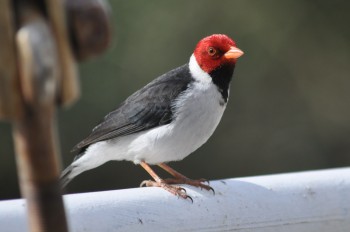 The bird which makes its presence most felt, alongside the riverbank, is actually not a great songster. He’s a squeaky toy – he cheeps like a European blue tit – but he’s as bold as a London sparrow. Before we had been here a week this little fellow and his wife were visiting us in the cockpit, hopping about in the rigging near our heads, saying, “Got any grub?”
The bird which makes its presence most felt, alongside the riverbank, is actually not a great songster. He’s a squeaky toy – he cheeps like a European blue tit – but he’s as bold as a London sparrow. Before we had been here a week this little fellow and his wife were visiting us in the cockpit, hopping about in the rigging near our heads, saying, “Got any grub?”
We put out some seeds of various sorts, and some crumbs of bread and cheese, and within five minutes we had two new pets.
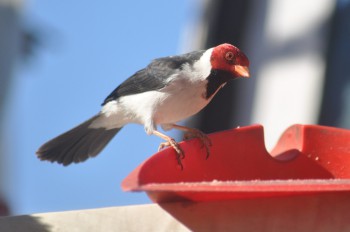
Known as cardenillas (yellow-billed cardinals, in English) our pet birds easily outshine a canary even if their voices are not so good. They wear a striking red velvet cap, and a black jacket over a crisp white shirt, and their “yellow” beaks are actually the colour of a carrot. Moreover, to see them gaily flitting around the boat and to and from the riverbank is tons more fun than watching a songbird go nuts inside the prison of a cage.
We call them Peter and Paula – of course. They are now so tame that they will eat from their table even while I am sitting immediately beside it, and one of them is brave enough to feed from a plate held in my outstretched arm. His mate keeps her distance and watches, with desire tempered by fear.
Sometimes I’d almost like to kill a mocking bird
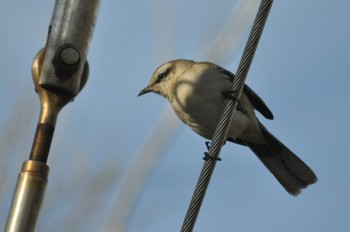
The principal chorister on the riverbank is the calandria, or mocking bird. In his shape and in his manner (or jizz) he resembles an over-large thrush, and his song, too, is quite similar. He spends a lot of time sitting on a high perch – now in this tall tree, now in that – telling the rest of the world that he is lord of all that he surveys. Like the English song thrush, he has to say everything twice. Unlike our thrush, the mocking bird is also very domineering and aggressive; indeed, in this respect he is more like the English blackbird – although even the blackbird will not go for a dog and I’ve been told that a mocking bird will!
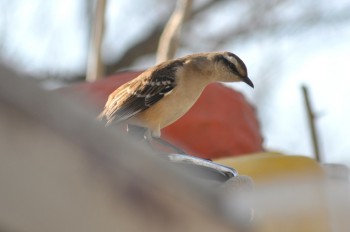
One thing that the mocking bird doesn’t hassle with is humans – but now that we’ve been here for a while he is bold enough to come aboard, provided that we are below-decks. If our little dicky birds are here, he bullies them. From the way that he behaves it looks to me as though he regards those sweet little things as crunchy, tasty morsels. They are less than a quarter of his size.
But as he flops across the cockpit in a half-hearted pounce the cardinals just flutter and squeak to a different perch, barely a yard away from him. They are always on the move; always twitchy. They are as mindful as antelope, feeding and yet keeping a constant look-out for lions. However, whereas I watch with bated breath as the bigger bird gets ready to strike, the cardinals are not fearful for their lives. They surely know the strength of that mocking bird’s beak to snap their spindly legs and crack open their skulls like a snail’s shell, but they are not preoccupied.
Perhaps we’re the same, dicing with death every time we drive our cars…
Kiskadee?
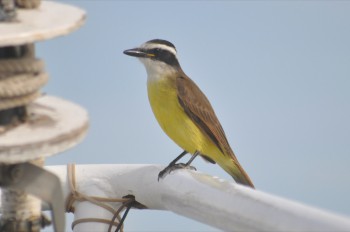
One other bird comes aboard the boat – but this one even more warily than the mocking bird. He is the kiskadee (or benteveo, in Spanish). Truly, I believe this bird must be the most ubiquitous of the Americas. His English name actually comes from the French, “Qu’est ce qu’il dit?”, and he is to be found as far north as Louisiana. His voice was pretty much the first that we heard when we arrived on the north-eastern corner of Brazil; it followed us all down the coast; and still we hear it on the Rio de la Plata. All day long the kiskadee trills and churrs and shouts, “What’s he saying?”
The Brazilians and the Spanish-speaking South Americans think he shouts, “I see you well!” – but to me the song sounds much more like kiskadee than benteveo; in fact, I knew who he was the very first time that I ever saw him, simply because of this tune.
The kiskadee seems a friendly sort of a chap and we like to have him around, but he, too, gets bullied by the mocking bird when he tries to visit our fast food restaurant. He also has a silly habit: he announces his arrival with a loud, “Hey!” When I hear this call I can seldom resist peeking outside; and a soon as I do that, he’s off.
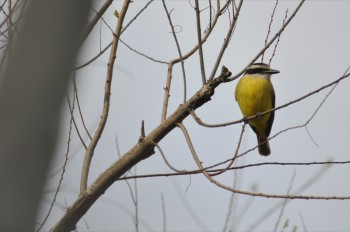
Perched in a tree, the kiskadee is very reminiscent of a kingfisher and I wonder if he might actually be a close relative. Hunched up, and twisting his head from side to side, he seems to be watching the water; but in fact he’s looking for flies. He swoops down, in the manner of a flycatcher, and plucks them from the air. His habit at our bird table is much the same; he seldom squats there, like the cardenillas or the mocking bird.
Primary colours
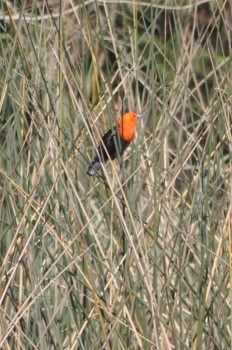
Quite the most astonishing bird to be seen on this riverbank is the federal, or scarlet-headed blackbird. In terms of his colouration this fellow is aptly named, for his body is black and his head – and the breast, and the upper-back – are a startling, wonderful, flaming scarlet. However, although he is as big as the English blackbird, this red-head is in no other respect the least like his namesake. He lives amongst the reeds, where he clings as ably as a warbler, and he sings loudly and in a tone of great urgency. His is the voice that I hear most often when I am meditating, although he never visits our side of the creek.
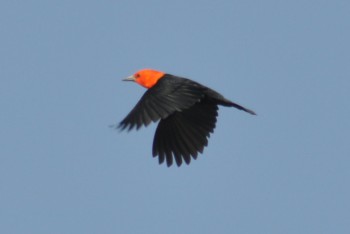
Other characters hide away in the reeds, churring and warbling in excitement or anger but never showing themselves to the world. One which I have glimpsed on a couple of occasions is another bi-coloured bird – again, predominantly black but this time with a bright yellow chest. He’s about the size and shape of a starling, and his Spanish name is Pecho Amarillo – which just means yellow-chest. His English name seems to be yellow-bellied marshbird.
Raptors
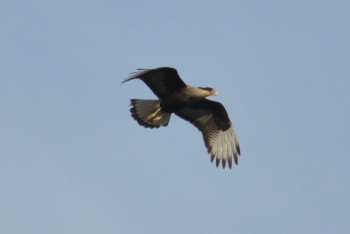
There are also birds of prey which live amongst the trees on the riverbank. The carancho (or caracara) is familiar to us from Brazil. He would gladly gobble down every one of the little birds – even the mocking bird would be no match for him – but he isn’t a hunter and he can’t go chasing around amongst the trees.
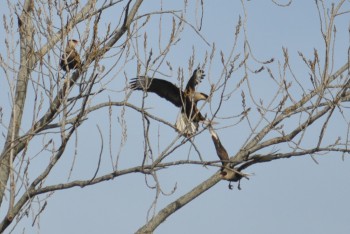
We generally see the caracaras floating by just above our masthead, searching for the dead and dying, but every now and then two or three of them settle in a tall tree on the far side of the river. To judge from their behaviour, they are Dad and Mum and one of last year’s offspring – with Junior being given his marching orders.
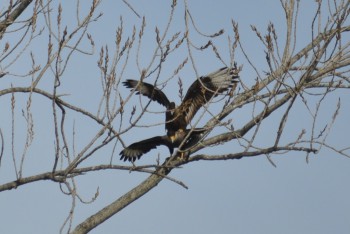
While the caracaras sit in the tree, yelling “Gronk” at one another, all is well; but when they step out onto the air and float over the island all hell breaks loose, for this flat area of land is the one chosen by the plovers as their nesting site. Whereas this raptor is too clumsy to take a bird in flight he certainly wouldn’t turn his back on a tasty chick, and the prospective parents know it. Blood-curdling shrieks fill the air, and my attention leaps away from the breath; I can’t resist the temptation to open my eyes and watch. Although I dislike their perpetual aggression I do admire the spunky manner in which the spur-winged plovers will pursue a bird which is four times their size and weight. Now I know why they need that weaponry!
Another occasional visitor to the river is the chimango. (A smaller species of caracara, whose English name I don’t know). This one is a hunter-scavenger, and when they hear him mewing, as he sweeps across the sky, the chatterers and chirpers and boasting songbirds fall quiet for a moment. But, again, they aren’t really afraid because they know that he can’t work amongst the trees or over the muddy strip of water. He needs the open ground behind the willows.
There are kestrels here, too – but they don’t hunt for birds; they eat mice. One who is a threat to the songsters, however, is a hawk with a malicious look in his eyes. Known locally as the aguilucho (or eaglet), his proper Spanish name is Taguato and his English name is the roadside hawk. This bird is ubiquitous – we have seen him frequently on our journey down the coast of South America – and he is bold enough to sit on our spreaders.
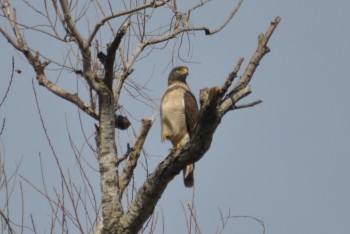
The aguilucho is a most beautiful bird, with handsome plumage and regal bearing. One can easily see how he got his nickname. His eye is a fierce blue; his finely hooked beak is grey and yellow. His chest is barred with russet stripes, his tail and finger-like wing-tips are barred, and his head is covered in a brown-black hood.
His Latin name puts him in the buzzard family, but for me Aguilucho is more like a marsh harrier. His tail is long and his wings are longer in proportion to his body than a buzzard’s. In his fierce attitude he is more like a sparrow hawk, although he doesn’t have that hunter’s psychopathic glint in his eye.
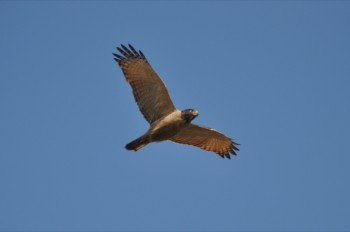
Like the Caracaras, Mr and Mrs Aguilucho are having a bit of trouble persuading last year’s family to leave home – and whereas the Carcaras seem only to have one stay at home, the Aguiluchos appear to have three. For several days now we’ve been treated to an almost non-stop battle, in which the birds yicker at one another from one side of the river to the other, or from adjacent trees. When the yick-yick-yickering reaches its angry peak, Dad hops from his perch and swoops upon his offspring. (Or at least, we assume it is Dad doing the attacking.) Whereas Master Caracara can take a hint, young Aggy can’t, and the attacks are becoming more angry and more vicious. This morning both birds tumbled out of a tree and fell thirty feet, to land in a tussling ball on the bank beside the boat.
Needless to say, I didn’t have my camera to hand…
This is the third article in our series about the Rio de la Plata.
The final article in the series is also about the local birdlife.
